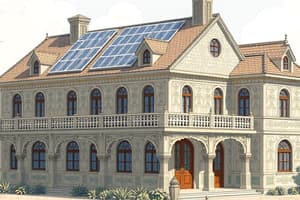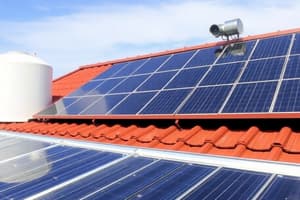Podcast
Questions and Answers
Which of the following is a primary disadvantage of solar energy?
Which of the following is a primary disadvantage of solar energy?
- Low initial installation cost
- Dependence on weather conditions (correct)
- Minimal environmental impact
- High energy conversion efficiency
What is the main function of mirrors in a solar cooker?
What is the main function of mirrors in a solar cooker?
- To reflect and concentrate sunlight onto the cooking area (correct)
- To dissipate excess heat
- To absorb infrared radiation
- To filter out harmful UV rays
In the context of a solar panel, what does the term 'module' typically refer to?
In the context of a solar panel, what does the term 'module' typically refer to?
- The supporting frame of the panel
- The wiring used to connect panels in an array
- The glass covering protecting the panel
- A group of solar cells connected together (correct)
What is the primary role of an inverter in a photovoltaic (PV) system connected to the power grid?
What is the primary role of an inverter in a photovoltaic (PV) system connected to the power grid?
What is the purpose of using a DC to DC converter in a PV system?
What is the purpose of using a DC to DC converter in a PV system?
What is the 'Greenhouse Effect'?
What is the 'Greenhouse Effect'?
Which of the following best describes an evacuated tube collector?
Which of the following best describes an evacuated tube collector?
What is the main difference between active and passive solar heating systems?
What is the main difference between active and passive solar heating systems?
Which of the following factors is most critical when determining the current that can be drawn from a battery?
Which of the following factors is most critical when determining the current that can be drawn from a battery?
To achieve a 450 Ah capacity using 12V lead-acid batteries with a 150 Ah rating each, what configuration is required?
To achieve a 450 Ah capacity using 12V lead-acid batteries with a 150 Ah rating each, what configuration is required?
In a buck converter circuit, what is the primary function of the switching element (e.g., MOSFET or BJT)?
In a buck converter circuit, what is the primary function of the switching element (e.g., MOSFET or BJT)?
What is the main purpose of a shunt-type charge controller in a solar power system?
What is the main purpose of a shunt-type charge controller in a solar power system?
When comparing concentrating and non-concentrating solar collectors, which statement accurately describes a key difference?
When comparing concentrating and non-concentrating solar collectors, which statement accurately describes a key difference?
In designing a solar panel system to power four 40W lights and a 100W fan, all used for 4 hours daily, what is the most critical factor in determining the solar panel's required power rating?
In designing a solar panel system to power four 40W lights and a 100W fan, all used for 4 hours daily, what is the most critical factor in determining the solar panel's required power rating?
Which parameter is NOT directly obtained from the V-I characteristics curve of a solar cell?
Which parameter is NOT directly obtained from the V-I characteristics curve of a solar cell?
When designing a battery system with a voltage requirement of 24V and capacity of 900Ah using 12V batteries with a 150Ah capacity, how should the batteries be configured?
When designing a battery system with a voltage requirement of 24V and capacity of 900Ah using 12V batteries with a 150Ah capacity, how should the batteries be configured?
Flashcards
Greenhouse Effect
Greenhouse Effect
Trapping of the sun's warmth in a planet's lower atmosphere due to the greater transparency of the atmosphere to visible radiation from the sun than to infrared radiation emitted from the planet's surface.
Evacuated Tube Collector
Evacuated Tube Collector
A solar thermal collector that uses an evacuated glass tube to reduce heat loss, increasing efficiency.
Sensible Heat Storage
Sensible Heat Storage
Storing thermal energy by heating or cooling a liquid or solid storage medium.
Natural Circulation Solar Water Heater
Natural Circulation Solar Water Heater
Signup and view all the flashcards
Active vs. Passive Solar Heating
Active vs. Passive Solar Heating
Signup and view all the flashcards
Hybrid PV Systems
Hybrid PV Systems
Signup and view all the flashcards
Solar Collector
Solar Collector
Signup and view all the flashcards
Inverter (in PV systems)
Inverter (in PV systems)
Signup and view all the flashcards
Concentrating Solar Collectors
Concentrating Solar Collectors
Signup and view all the flashcards
Non-concentrating Solar Collectors
Non-concentrating Solar Collectors
Signup and view all the flashcards
Fresnel Lens Collector
Fresnel Lens Collector
Signup and view all the flashcards
Solar Crop Dryer
Solar Crop Dryer
Signup and view all the flashcards
Medium Temperature Solar Power Plant
Medium Temperature Solar Power Plant
Signup and view all the flashcards
Absorption Space Cooling
Absorption Space Cooling
Signup and view all the flashcards
Solar Greenhouses
Solar Greenhouses
Signup and view all the flashcards
Balance of System (BOS)
Balance of System (BOS)
Signup and view all the flashcards
Study Notes
- This document contains the Renewable Energy Engineering I diploma examination questions from November 2024.
- The exam is divided into three parts: A, B, and C and has a maximum mark of 75 and a time duration of 3 hours.
Part A
- Part A requires answering all of the questions in one word or one sentence, and each question is worth one mark (9 x 1 = 9 Marks).
- Questions include:
- Listing two disadvantages of solar energy.
- Defining a solar collector.
- Defining purpose of using mirrors in a solar cooker.
- Defining purpose of solar stills.
- Defining what the word module refers to in a solar panel?,
- Listing the major components required for an on-grid PV installation.
- Stating the purpose of inverter in PV systems.
- Stating the function of the DC to DC converter in PV systems.
- Listing any applications of solar PV.
Part B
- Part B requires answering any eight questions each worth three marks (8 x 3 = 24 Marks).
- Questions include:
- Explaining the Greenhouse Effect.
- Explaining the evacuated tube type collector.
- Explaining the theory behind sensible heat storage.
- Explaining the working of a natural circulation solar water heater.
- Comparing active and passive solar heating systems.
- Drawing the block diagram of hybrid PV systems.
- Estimating the current that can be drawn from a 100Ah capacity battery discharged for 10 hours.
- Showing the method of obtaining 450 Ah capacity using 12 V lead acid batteries of 150Ah.
- Explaining the working of a buck converter with the help of a diagram.
- Explaining the working of a shunt type charge controller with the help of a block diagram.
Part C
- Part C requires answering all the questions and each question carries seven marks (6 x 7 = 42 Marks).
- Questions include:
- Comparing concentrating and Non-concentrating Type solar collectors or explaining the Fresnel lens type concentrating collector with a suitable diagram.
- Explaining the working of a solar crop dryer with a suitable diagram or explaining the working of a medium temperature solar power plant with the help of a diagram.
- Explaining the working of an absorption type space cooling with the help of a block diagram or explaining the solar green houses and giving their classifications.
- Calculating the rating of the solar panel to be selected if we want to power up four lights of 40W and a fan of 100W which are being used for 4 hours everyday, assuming the sunshine is available for 4 hours or drawing the V I characteristics of a solar cell and define the terms related to it.
- Explaining the working of a PWM charge controller with the help of suitable block diagrams or designing the battery system for a voltage requirement of 24 V and a capacity of 900 Ah, given that available batteries have voltage of 12V and capacity of 150Ah.
- Explaining the components of Balance of System(BOS) or explaining Solar PV application in water pumping with the help of a block diagram.
Studying That Suits You
Use AI to generate personalized quizzes and flashcards to suit your learning preferences.




